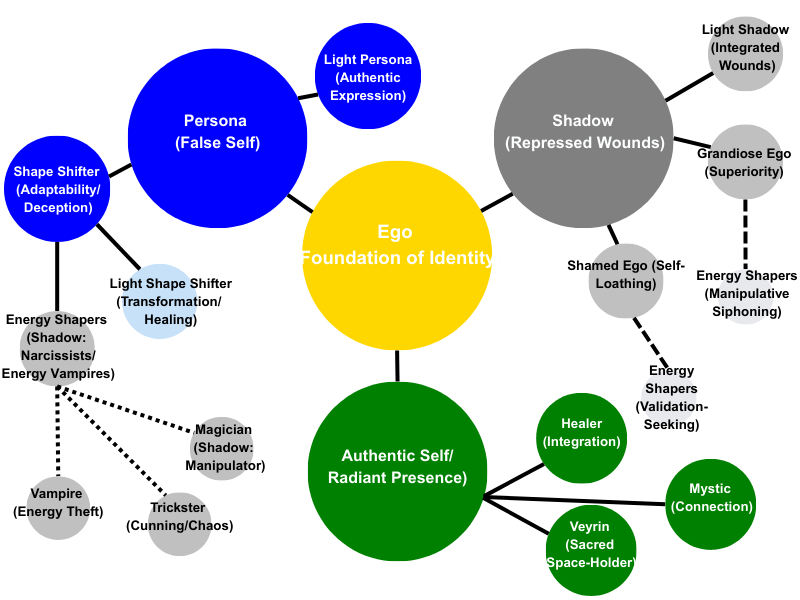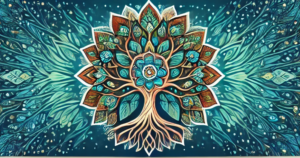From Narcissists to Energy Shapers (Part 1 of 3)
“Narcissism is a seductive mask that hides a fragile soul, yearning for love it cannot give.” — Dr. Ramani Durvasula

Energy Shapers in Spiritual Communities
I once believed narcissists and energy vampires would avoid spiritual communities, assuming their aversion to self-awareness would keep them from spaces rooted in “know thyself.” A couple of deeply personal encounters shattered that notion, revealing not only their presence but their prevalence—potentially two to three times higher than in the general population, where studies estimate 6.2% of adults exhibit traits of Narcissistic Personality Disorder (NPD) (American Psychiatric Association, 2013). These individuals blend seamlessly into spiritual circles, wielding jargon and exploiting openness to siphon energy, often leaving lasting wounds. To foster healing dialogue, I’ve reframed them as Energy Shapers, a term that captures their impact while pointing to their potential for transformation. This post explores who Energy Shapers are, how they’re formed, why they thrive in spiritual communities, and how to spot them, using Archetypal Pentad 9: Ego’s Illusion and an archetypal hierarchy to ground the conversation in a trauma-informed lens.
My Story: A Collision with an Energy Shaper
Before exploring definitions and archetypes, I want to share my story—a collision that reshaped my understanding of spiritual communities. I met someone in a spiritual setting who appeared kind, open-hearted, and wise. Their words were captivating, filled with talk of unity, service, and love, suggesting a deep commitment to their spiritual path. Yet, over time, their actions revealed a stark contrast. The charisma that first drew me in morphed into self-absorption, marked by an inflated ego, a relentless need for attention and praise, subtle manipulations, and a disregard for my boundaries. I poured time and energy into supporting them, only to be met with empty promises or absence when I sought reciprocity. The aftermath was devastating—emotional exhaustion, eroded trust in spiritual spaces and people, and a lingering sense of self-doubt. It forced me to confront what it was within me that made me vulnerable to such dynamics, examining my boundaries and sense of worth. Sadly, this wasn’t an isolated incident; I’ve encountered an abundance of similar patterns since, though thankfully I learned my lesson well. These painful experiences taught me the critical importance of discernment and self-protection, guiding me to The Integrated Path to Awakening (TIPA) and a renewed dedication to authentic connection. They also inspired the term “Energy Shapers,” a way to name the harm without shunning, inviting healing for all.
Who Are Narcissists and Energy Vampires?
Narcissists, as defined by the DSM-5, exhibit a pervasive pattern of grandiosity, a need for admiration, and a lack of empathy, diagnosed as NPD when five or more traits are present, including exaggerated self-importance, entitlement, and exploitative behavior (American Psychiatric Association, 2013). NPD affects 0.5-5% of the U.S. population, with higher prevalence among men (7.7%) than women (4.8%) (Stinson et al., 2008). Narcissistic traits exist on a spectrum, impacting spiritual communities even without a diagnosis, as their self-esteem relies on external approval, making them adept at manipulation.
Energy vampires drain others’ emotional or psychic energy to feel validated, often overlapping with narcissistic traits. Spiritual teacher Jeffrey Martin describes them as creating warmth to gain acceptance, masking self-centeredness that leaves others depleted (Martin, 2020). In spiritual settings, they target empaths, feeding off attention, sympathy, or conflict. Both disrupt group energy, exploiting the openness of spiritual circles, with up to 60% of trauma survivors exhibiting related energy-draining behaviors (van der Kolk, 2014).
Introducing Energy Shapers: A New Term for Healing Dialogue
While “narcissist” and “energy vampire” are recognizable, their weight—clinical for one, predatory for the other—can shut down conversation, shunning both those harmed and those exhibiting the behavior. I propose “Energy Shapers”, a neutral term that captures their active, often deceptive manipulation of energy while pointing to their potential for transformation. This shift fosters dialogue in spiritual communities, acknowledging the “deeply injuring” impact without vilifying the person, who is often acting from trauma (Young & Klosko, 1993).
Why Energy Shapers?
The term reflects their archetypal roots and aligns with TIPA’s healing framework:
- Archetypal Subpatterns: Energy Shapers are a composite shadow state, drawing from:
- Vampire (Caroline Myss): Drains energy through manipulation, like emotional demands or guilt-tripping, to compensate for depletion (Myss, 2001). Their light side sources energy internally, becoming healers.
- Shape Shifter: Adapts personas (guru, victim, child, lover) to siphon energy, using deception to gain power, as in shamanic traditions (Jung, 1964). Their light side transforms for growth.
- Trickster: Employs cunning or chaos, like love-bombing or conflict, to capture attention (Campbell, 1949). Their light side disrupts for positive change.
- Magician (Shadow: Manipulator): Uses charisma to control, posing as spiritual leaders to dominate (Moore & Gillette, 1990). Their light side empowers authentically.
- Pentad 9: Ego’s Illusion: This framework, found in The Integrated Path to Awakening (TIPA), maps Energy Shapers’ journey:
- Ego’s Illusion (Precursor): Seeks validation from insecurity, anxious to prove worth.
- Shamed Ego (Shadow – Dorsal Vagal): Collapses into self-loathing (“I’m worthless”), seeking praise to mask shame.
- Grandiose Ego (Shadow – Sympathetic Vagal): Projects superiority (“I’m above others”), manipulating energy.
- Authentic Self (Balanced): Embraces true identity, valuing self and others equally (ventral vagal).
- Radiant Presence (Elevated): Radiates light, inspiring unity (ventral vagal). Energy Shapers embody Shamed Ego (seeking validation) and Grandiose Ego (deceptive siphoning), with potential to reach Authentic Self and Radiant Presence through healing.
- Archetypal Hierarchy: Energy Shapers are a shadow subset of the Shape Shifter, under the Ego’s Persona, blending Vampire’s energy theft, Trickster’s cunning, and Magician’s control. The hierarchy (visualized below) roots them in the Ego, with Shamed/Grandiose Ego driving their behavior, and Self (Authentic Self/Veyrin) as the healing goal.

This mind map illustrates the archetypal hierarchy, a framework of universal patterns within our psyche, showing how Energy Shapers—narcissists and energy vampires—emerge from the Ego, our core identity. The Persona (blue) represents the masks we wear, where Shapers use deception (Shape Shifter) to manipulate, driven by sub-archetypes like Vampire (energy theft) and Trickster (cunning). The Shadow (gray) reveals repressed wounds, with Shapers fueled by self-loathing (Shamed Ego) or superiority (Grandiose Ego), often linked to addictive behaviors like seeking validation. The Self (green) offers healing, embodying authenticity through archetypes like Healer and Veyrin (sacred space-holder). In spiritual communities, Shapers exploit trust, but healing transforms their harm into growth, as explored in Posts 2 and 3 with TIPA’s support.
- Why It’s Helpful: “Energy Shapers” is neutral, reducing stigma to invite dialogue, unlike “narcissist” (6.2% prevalence, American Psychiatric Association, 2013) or “vampire.” It highlights active manipulation (Grandiose Ego’s tactics) while showing the light potential (Shape Shifter’s transformation, Radiant Presence). This fosters accountability without shunning, aligning with TIPA’s ethos of compassionate inclusion, while also honoring the harm experienced.
From here, I’ll use “Energy Shapers” to describe these dynamics, reflecting their composite nature and healing path.
How Are Energy Shapers Formed?
Energy Shapers arise from childhood experiences, with 50-75% of NPD variance heritable and environment playing a key role (Torgersen et al., 2000). Common scenarios include:
- Excessive Praise and Overvaluation: Overpraised children develop entitlement and fragile self-esteem (Brummelman et al., 2015).
- Emotional Neglect and Inconsistent Validation: Unavailable parents drive children to seek attention through manipulation (Young & Klosko, 1993).
- Excessive Criticism and Conditional Love: Performance-based love fosters grandiosity to mask unworthiness (Kohut, 1977).
- Parental Modeling of Narcissistic Traits: Children adopt entitlement from narcissistic parents (Imbesi et al., 2019).
These create an inner void, with Energy Shapers’ behaviors (Pentad 9: Shamed Ego/Grandiose Ego) as coping mechanisms. This trauma-driven origin fosters compassion for their healing journey.
Why Do Energy Shapers Thrive in Spiritual Communities?
Spiritual communities’ compassion and non-judgment attract Energy Shapers, whose wounds fuel validation hunger:
- Access to Attention: Group sharing feeds their need for recognition, drawing on Vampire and Trickster traits (Martin, 2020).
- Control Over Vulnerable Individuals: Seekers in transition are targets for Shapers posing as mentors or guides, using Magician’s charisma (Brown, 2016).
- Using Vulnerability as Currency: Exaggerated wounds monopolize attention, a Shape Shifter tactic.
- Environment of Trust and Openness: Non-judgment reduces scrutiny, enabling manipulation (Durvasula, 2019).
- Ambiguous Power Structures: Fluid hierarchies allow control, blending all subpatterns.
Spiritual settings attract personality disorders due to inclusivity (Lukowitsky & Pincus, 2013). Dr. Ramani Durvasula notes Shapers co-opt terms like “holding space” to evade accountability, weaving energy webs (Durvasula, 2019).
The Difference Between Masculine and Feminine Expressions
Energy Shapers’ traits vary by gender socialization, reflecting their archetypal roots:
- Masculine Expressions: Assertive, they interrupt or act as advisors, using Trickster’s flattery or Magician’s dominance. They seek control through debate, drawing on Vampire’s energy theft (Twenge & Campbell, 2009).
- Feminine Expressions: Relational, they play the “empath,” creating dependency with Shape Shifter’s adaptability. They overshare or gossip, using Vampire’s emotional siphoning (Grijalva et al., 2015).
Both exploit openness, blending subpatterns to shape energy dynamics.
Spotting the “Wolf in Sheep’s Clothing”
Energy Shapers disguise themselves, but Pentad 9 reveals their patterns:
- False Persona and “Chameleoning”: Crafting warm personas, they adapt to group needs, commandeering spiritual jargon (Grandiose Ego, Shape Shifter) (Durvasula, 2019).
- Grandiose Entitlement: Claiming divine gifts, heroic journeys, or deep mystical experiences, they form alliances to maintain influence (Grandiose Ego, Magician).
- Lack of True Accountability: Deflecting blame, they claim instant healing without change, thriving on praise or conflict (Shamed Ego, Trickster).
- Superficial Empathy: Platitudes vanish when needs arise, with excuses avoiding accountability (Shamed Ego, Vampire).
- Boundary Violations: Love-bombing/bread-crumbing creates dependency, followed by devaluation (Grandiose Ego, Shape Shifter).
- Taking Up All the Space: Extroverted Shapers dominate; introverted ones manipulate one-on-one, siphoning energy (Grandiose Ego, Vampire).
Sandra L. Brown warns spiritual circles’ empathy makes them vulnerable (Brown, 2016). Recognizing these protects energy with compassion.
Do Energy Shapers Belong in Spiritual Communities?
Energy Shapers deserve a place to heal, as Pentad 9’s Authentic Self and Radiant Presence suggest. Relationships reveal shadows for growth (Young & Klosko, 1993). However, their manipulation disrupts group energy and the sense of safety, which are vital for collective healing (Martin, 2020). Compassionate inclusion with accountability fosters growth.
Conclusion: Seeing the Hungry Ghosts
Energy Shapers, as Pentad 9 reveals, are wounded seekers whose manipulative patterns disrupt spiritual communities, leaving lasting wounds for those they target. Recognizing their traits—false personas, entitlement, boundary violations—empowers us to protect our energy with compassion. Post 2, Understanding Energy Shapers and Their Impact, delves deeper into the profound trauma inflicted by these hungry ghosts, exploring their impact across all contexts and the unique dynamics with empaths and healers, paving the way for healing and understanding.
References:
- American Psychiatric Association. (2013). Diagnostic and Statistical Manual of Mental Disorders (DSM-5). American Psychiatric Publishing. https://www.psychiatry.org/psychiatrists/practice/dsm
- Brown, S. L. (2016). Women Who Love Psychopaths: Inside the Relationships of Inevitable Harm with Psychopaths, Sociopaths, and Narcissists. Mask Publishing. https://www.sandralbrownma.com/
- Brummelman, E., Thomaes, S., Nelemans, S. A., Orobio de Castro, B., Overbeek, G., & Bushman, B. J. (2015). Origins of narcissism in children. Proceedings of the National Academy of Sciences, 112(12), 3659–3662. https://www.pnas.org/content/112/12/3659
- Campbell, J. (1949). The Hero with a Thousand Faces. Pantheon Books. https://www.jcf.org/works/titles/the-hero-with-a-thousand-faces
- Durvasula, R. (2019). Don’t You Know Who I Am? How to Stay Sane in an Era of Narcissism, Entitlement, and Incivility. Post Hill Press. https://www.dr-ramani.com/
- Grijalva, E., Newman, D. A., Tay, L., Donnellan, M. B., Harms, P. D., Robins, R. W., & Yan, T. (2015). Gender differences in narcissism: A meta-analytic review. Psychological Bulletin, 141(2), 261–310. https://www.ncbi.nlm.nih.gov/pmc/articles/PMC4410736/
- Imbesi, J., Kocum, L., & O’Neil, J. (2019). Narcissistic parents and their children: A review of the literature. Journal of Child and Family Studies, 28(8), 2089–2099. https://www.ncbi.nlm.nih.gov/pmc/articles/PMC6699597/
- Jung, C. G. (1964). The Archetypes and the Collective Unconscious. Princeton University Press. https://press.princeton.edu/books/paperback/9780691018331/archetypes-and-the-collective-unconscious
- Kohut, H. (1977). The Restoration of the Self. International Universities Press. https://www.routledge.com/The-Restoration-of-the-Self/Kohut/p/book/9780226450131
- Lukowitsky, M. R., & Pincus, A. L. (2013). Interpersonal perception of pathological narcissism: A social relations analysis. Journal of Personality Assessment, 95(3), 261–273. https://www.ncbi.nlm.nih.gov/pmc/articles/PMC3874338/
- Martin, J. (2020). The Finders. Integration Press. https://www.drjeffreymartin.com/
- Moore, R., & Gillette, D. (1990). King, Warrior, Magician, Lover: Rediscovering the Archetypes of the Mature Masculine. HarperCollins. https://www.harpercollins.com/products/king-warrior-magician-lover-robert-moore-douglas-gillette
- Myss, C. (2001). Sacred Contracts: Awakening Your Divine Potential. Harmony Books. https://www.myss.com/archetypes/
- Stinson, F. S., Dawson, D. A., Goldstein, R. B., Chou, S. P., Huang, B., Smith, S. M., … & Grant, B. F. (2008). Prevalence, correlates, disability, and comorbidity of DSM-IV narcissistic personality disorder: Results from the Wave 2 National Epidemiologic Survey on Alcohol and Related Conditions. The Journal of Clinical Psychiatry, 69(7), 1033–1045. https://www.ncbi.nlm.nih.gov/pmc/articles/PMC2669229/
- Torgersen, S., Lygren, S., Øien, P. A., Skre, I., Onstad, S., Edvardsen, J., … & Kringlen, E. (2000). A twin study of personality disorders. Comprehensive Psychiatry, 41(6), 416–425. https://pubmed.ncbi.nlm.nih.gov/10933479/
- Twenge, J. M., & Campbell, W. K. (2009). The Narcissism Epidemic: Living in the Age of Entitlement. Free Press. https://www.amazon.com/Narcissism-Epidemic-Living-Age-Entitlement/dp/1416575995
- van der Kolk, B. A. (2014). The Body Keeps the Score: Brain, Mind, and Body in the Healing of Trauma. Penguin Books. https://www.besselvanderkolk.com/resources/the-body-keeps-the-score
- Young, J. E., & Klosko, J. S. (1993). Reinventing Your Life: The Breakthrough Program to End Negative Behavior and Feel Great Again. Penguin Books. https://www.schematherapy.com/


 C M Rumble & Rowan Holistic Healing and Wellness
C M Rumble & Rowan Holistic Healing and Wellness
